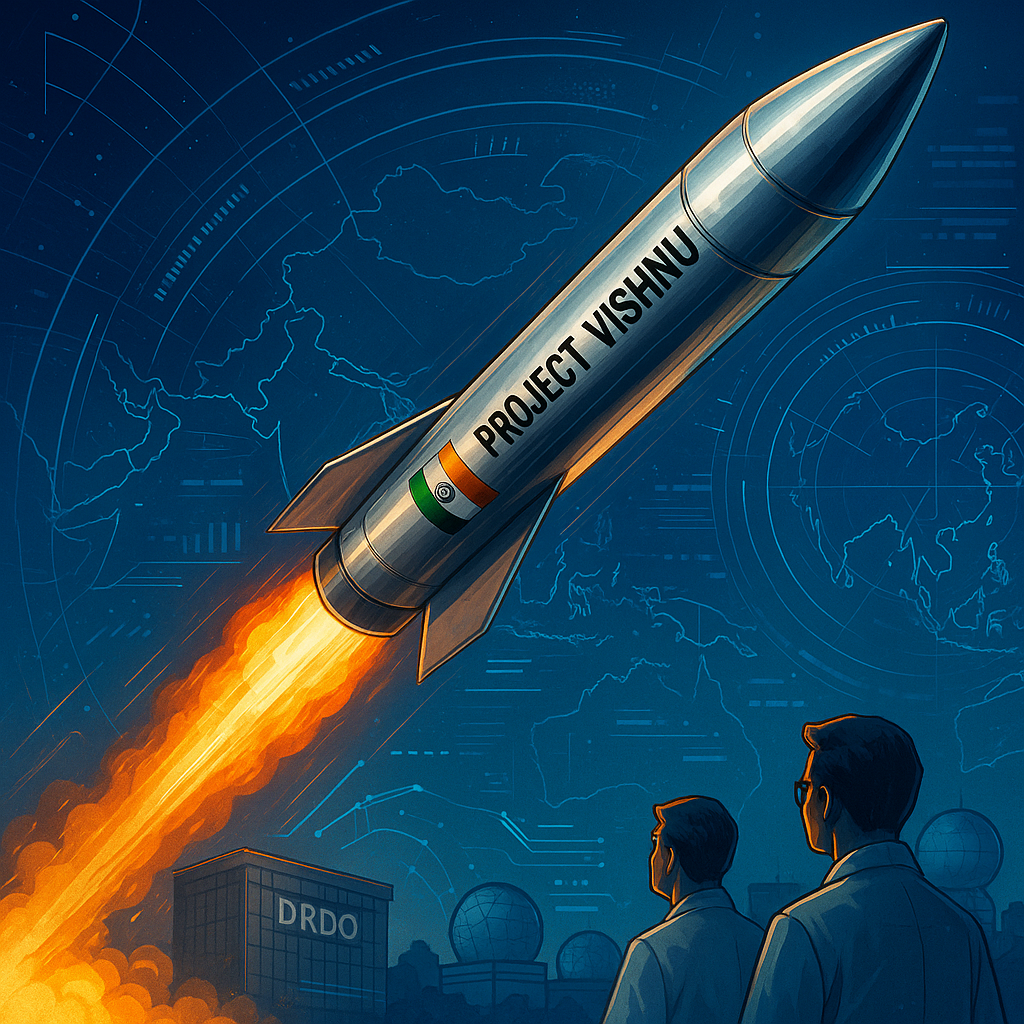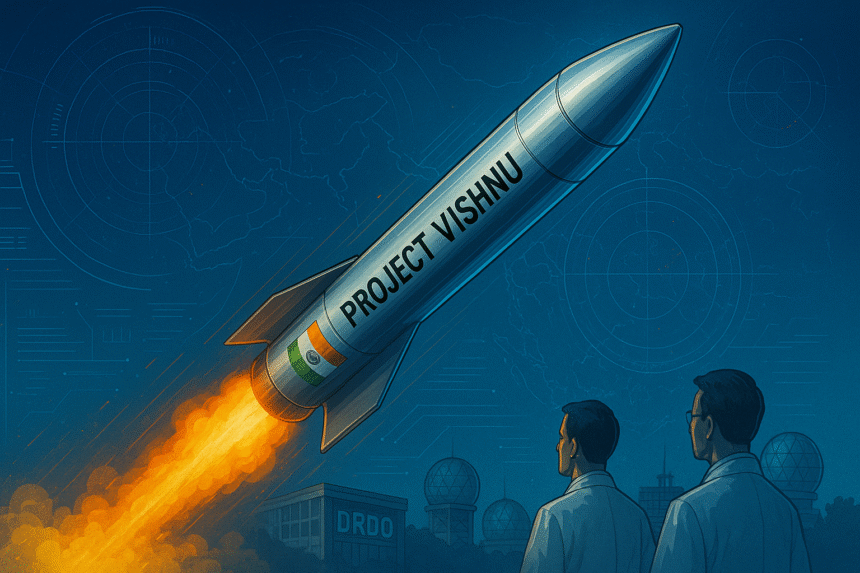“They say lightning never strikes the same place twice.
But what if you could aim the lightning?”
– That’s India’s plan with its DRDO Hypersonic Missile under Project Vishnu.
While global powers are flexing their hypersonic muscles — USA with HAWC, China with DF-ZF, and Russia with Avangard — India has quietly unveiled a bold and futuristic ambition of its own. And no, it’s not just about matching the pace. It’s about rewriting the rules of modern warfare.
- 🇮🇳 What Is Project Vishnu All About?
- 🧠 Why “Hypersonic” Is the Buzzword of the Decade?
- 🎯 What Sets the DRDO Hypersonic Missile Apart?
- 🔍 Why the World Is Watching (Especially Pakistan and China)
- 🔬 DRDO’s Journey So Far: From BrahMos to Vishnu
- 📦 Payload Power: What Can It Carry?
- 🛡️ Can It Be Stopped? Short Answer: No
- 🧪 Challenges Ahead: It’s Not All Mach and Glory
- 🔮 What Next? The Road to Deployment
- 🧠 Final Thoughts: Hypersonic Isn’t Just About Speed — It’s About Superiority
Introducing: Project Vishnu – the mythical name of India’s high-speed, high-impact missile project, spearheaded by the DRDO Hypersonic Missile Program.
Buckle up. Because this blog is going to be faster than Mach 6!
🇮🇳 What Is Project Vishnu All About?
Let’s start from the launchpad.
Project Vishnu is India’s top-secret (now not-so-secret) initiative to develop long-range hypersonic cruise missiles under the leadership of the Defence Research and Development Organisation (DRDO). The goal? Build a missile capable of:
- Flying at speeds above Mach 6 (7400+ km/h)
- Maneuvering mid-air like a guided dragon
- Carrying both conventional and nuclear warheads
- Covering 1,500 km+ range, with pinpoint accuracy
Think of it as the BrahMos on steroids — but smarter, faster, stealthier.

🧠 Why “Hypersonic” Is the Buzzword of the Decade?
We’ve had supersonic missiles for decades. But hypersonic weapons have officially entered the chat, bringing with them five key advantages:
- Insane Speed: They travel 5 to 10 times faster than sound.
- Unpredictable Paths: Unlike ballistic missiles, they can change direction mid-flight.
- Almost Impossible to Intercept: Most air defense systems are designed for predictable threats.
- Survivability: They can dodge, duck, dip, dive, and dodge. (Yes, that’s a Dodgeball reference.)
- Dual Capability: Equipped for both nuclear and conventional strikes.
Which brings us to the main reason why everyone from Washington to Wuhan is sweating over this — strategic dominance.
🎯 What Sets the DRDO Hypersonic Missile Apart?
India’s version isn’t just another copycat model. DRDO is playing it smart and indigenous.
Key differentiators of India’s hypersonic missile:
- Boost-glide technology: The missile uses a traditional rocket booster for lift-off, but then glides at hypersonic speeds — making tracking it nightmarishly difficult.
- Scramjet engine research: DRDO has been developing scramjet tech since 2016, with a successful test of the Hypersonic Technology Demonstrator Vehicle (HSTDV).
- Dual launch platforms: Project Vishnu aims to make the missile launchable from both land-based systems and air platforms.
- Thermal shielding: Can survive re-entry temperatures that make lava look lukewarm.
Bonus? It’s being developed 100% indigenously — that’s Make in India going Mach 6!
🔍 Why the World Is Watching (Especially Pakistan and China)
Let’s address the elephant — or rather, the dragon — in the room.
Both China and Russia have operational hypersonic missiles. The DF-ZF (China) and Avangard (Russia) have already turned heads at Pentagon and NATO summits.
But here’s what’s making India’s neighbors sit up nervously:
- Pakistan’s defense systems are ill-equipped to detect, let alone intercept, a Mach 6 missile.
- China’s strategy of A2/AD (Anti-Access/Area Denial) zones could be cracked by a fast, maneuvering missile like Project Vishnu’s final product.
This makes DRDO hypersonic missile the new wildcard in Asia’s security game.
And yes, even USA and Israel are watching closely. With India rising as a global strategic partner, this tech has serious geopolitical implications.
🔬 DRDO’s Journey So Far: From BrahMos to Vishnu
India isn’t a stranger to missile mastery.
- Agni & Prithvi series proved India’s strategic strength.
- BrahMos, co-developed with Russia, became the world’s fastest supersonic cruise missile.
- Now, Project Vishnu aims to carry that legacy forward — into the hypersonic era.
In 2020, DRDO successfully tested the HSTDV, achieving Mach 6 speeds for 23 seconds. Since then, the race has been on to scale up the prototype, stabilize scramjet propulsion, and weaponize it for operational use.
Think of it like going from a prototype flying car to launching a Ferrari F-35 — and still keeping it desi.
📦 Payload Power: What Can It Carry?
We’re not just talking about fireworks. We’re talking serious firepower.
The upcoming DRDO hypersonic missile will likely carry:
- Conventional payloads to neutralize strategic installations
- Nuclear warheads for full-spectrum deterrence
- EMP or penetration devices to disable radar and air defense
Whether it’s surgical strike precision or full-throttle annihilation, the flexibility of payloads is what makes Project Vishnu missile both a sword and a shield.
🛡️ Can It Be Stopped? Short Answer: No
One of the reasons why DRDO hypersonic missile is such a big deal is this:
There’s almost no defense system today that can reliably intercept a hypersonic glide vehicle.
Even state-of-the-art systems like:
- THAAD (US)
- S-500 (Russia)
- Iron Dome (Israel)
…struggle with the unpredictability and speed of hypersonic threats.
That means India’s enemies would literally have seconds to respond. And that’s terrifying (for them) and reassuring (for us).
🧪 Challenges Ahead: It’s Not All Mach and Glory
Of course, this isn’t easy science.
Developing a hypersonic missile involves:
- Managing thermal stress (temperatures exceed 1000°C)
- Perfecting scramjet engines, which ignite only at Mach 5+
- Ensuring navigation accuracy at insane speeds
- Creating launch platforms that can withstand the physics of hypersonic thrust
DRDO is walking a tightrope of physics, engineering, and strategy. But if anyone can do it, it’s the scientists who made India’s Mars mission cheaper than Hollywood’s Gravity.
🔮 What Next? The Road to Deployment
Here’s what insiders and defense experts predict:
- Full operational readiness by 2028
- Integration with aircraft like Su-30 MKI or future AMCA
- Deployment along strategic borders and naval platforms
- Joint development with friendly nations (hint: Israel, France)
If successful, DRDO hypersonic missile under Project Vishnu will place India firmly in the elite hypersonic club.
🧠 Final Thoughts: Hypersonic Isn’t Just About Speed — It’s About Superiority
The development of the DRDO hypersonic missile isn’t just a technological milestone. It’s a geopolitical statement.
India is no longer playing catch-up. It’s sprinting ahead with mythological flair — Project Vishnu being a perfect metaphor: multi-armed, multi-dimensional, and mission-ready.
As the world stares down a future shaped by AI, drones, and cyberwarfare — don’t forget, it might just be a hypersonic missile from India that defines deterrence in 2030.
So, next time someone says “India is slow in defense tech,”
just smile and whisper:
“Ever heard of Project Vishnu?”












